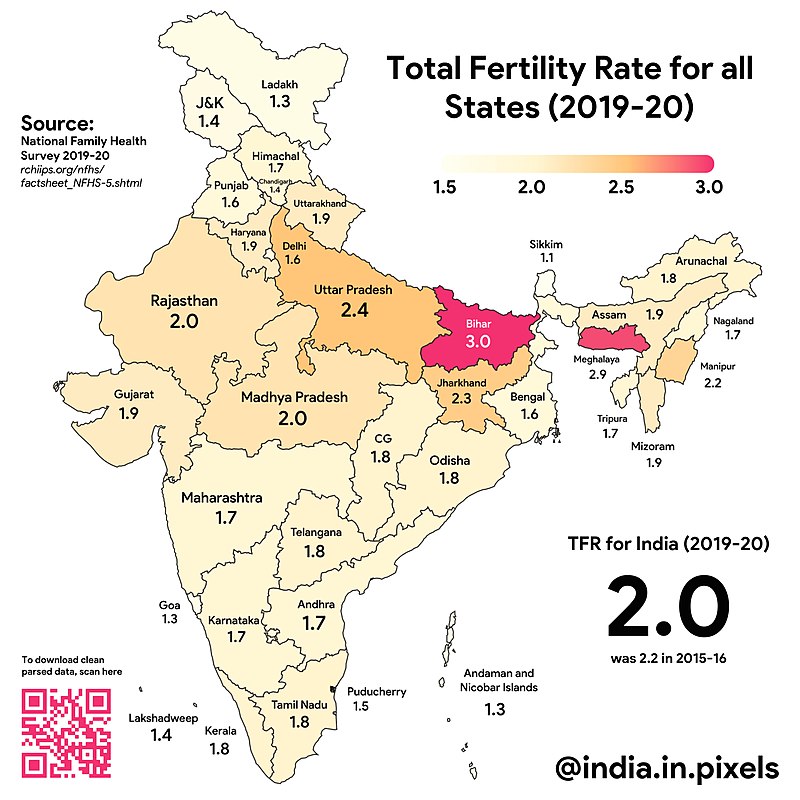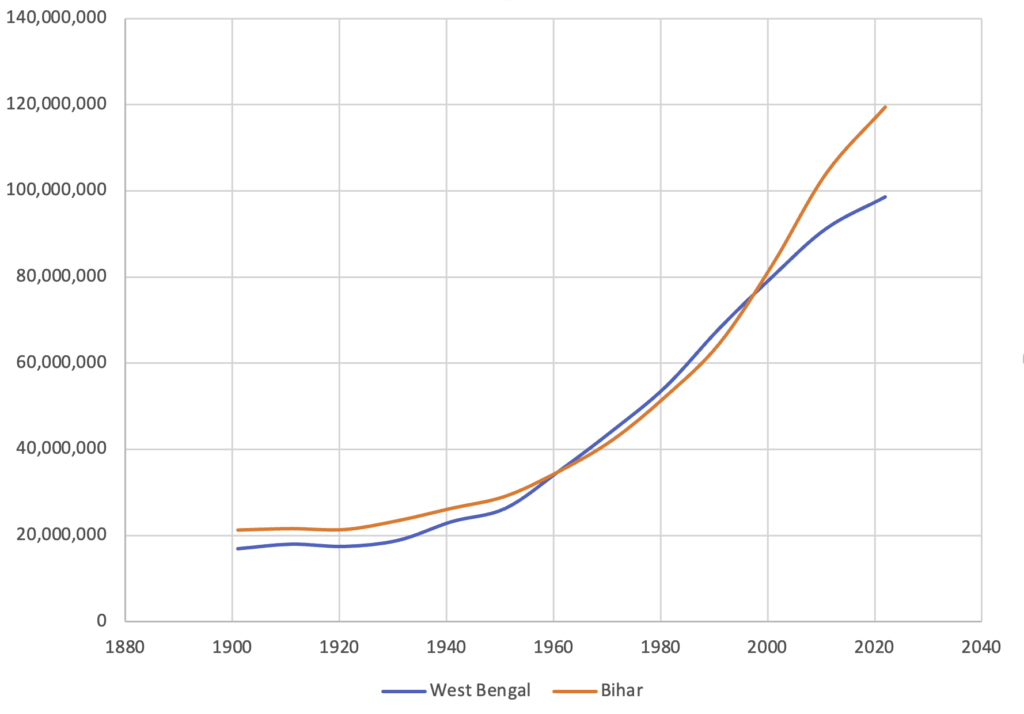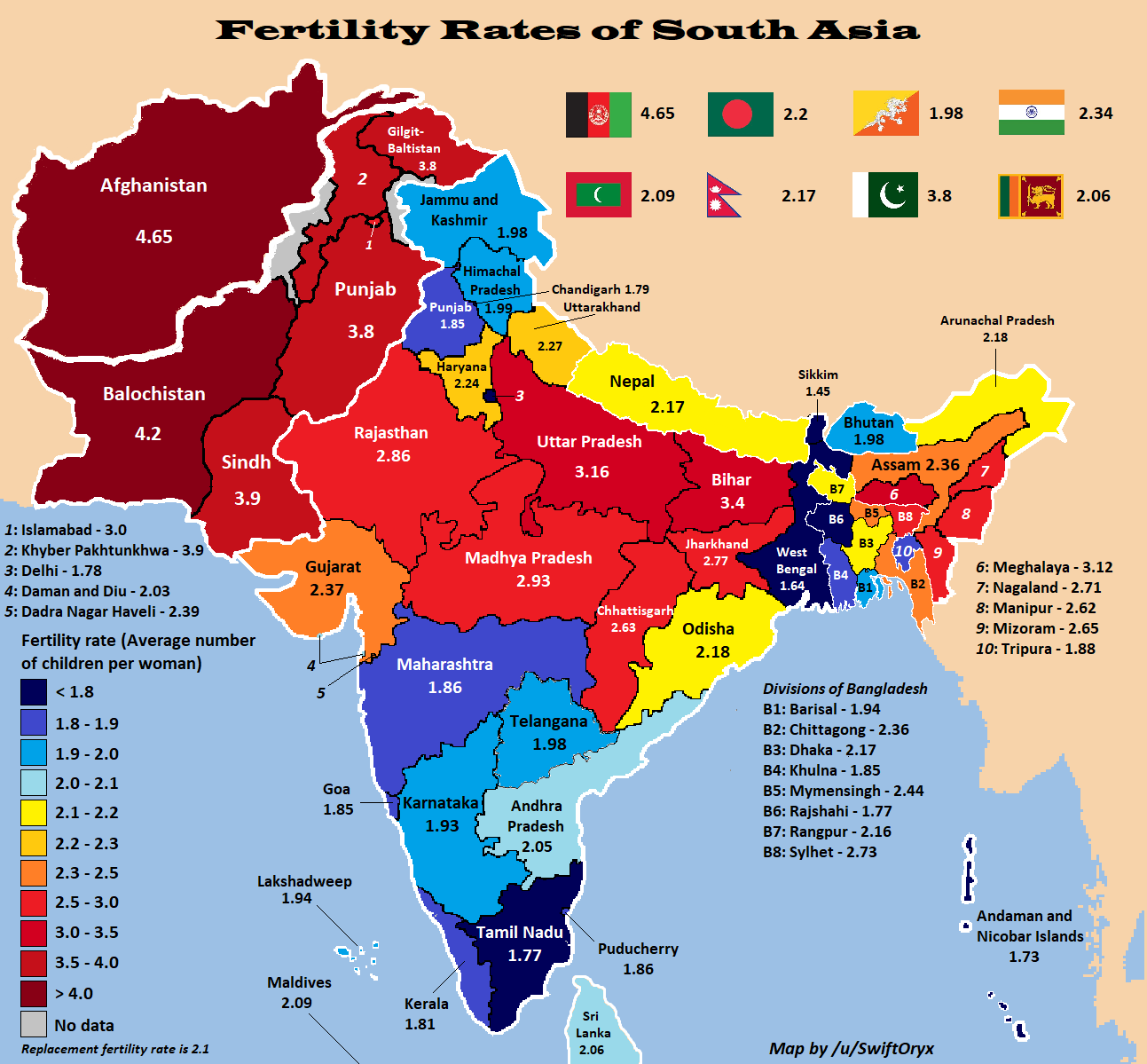I’ve fascinated by regions that border each other and have very different fertilities. For example, Saudi Arabia has a TFR of 2.2 and Yemen one of 4. Today it looks like Bihar has a fertility of around 3.0 and West Bengal 1.6. Bihar surpassed West Bengal in the late 1990’s, and is still more populous even without Jharkhand. But the data below suggest to me that West Bengal experienced a “windfall” population growth with the arrival of Hindus from East Pakistan and Bangladesh in the decades after partition, and we’re sort of reverting back to the mean…
Category: Data
Indian CEOs in America are a knock on of India’s specific economic strengths
What are the broader takeaways from the apparent success of India trained CEOs in the US ? The usual Darwinian (best and brightest) or ‘sheer population’ arguments are attractive but dont withstand scrutiny. A broader explanation is that India has been disproportionately successful in producing corporate leaders (much like certain populations in the past were successful at producing generals or merchants), and due to trade and immigration links, some of its success has overflowed to the US as well.
Since 1984, India’s stock exchange has provided returns of an astounding 10,000%. Even the Dow Jones (3700%) has returned a fraction of the BSE’s returns.
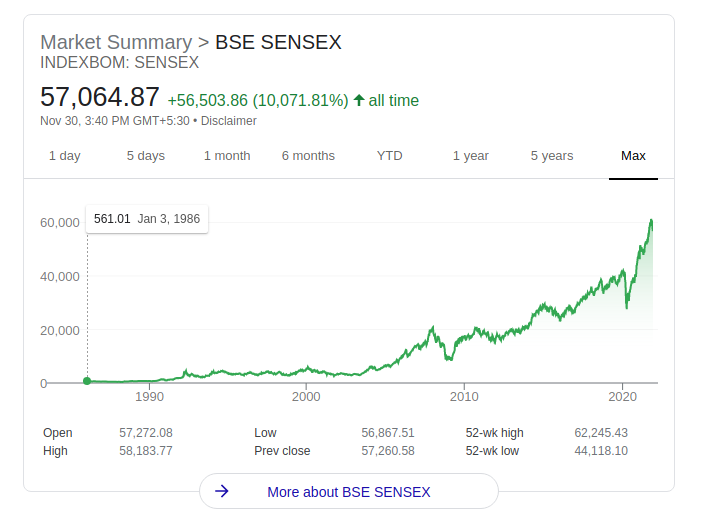
This is a nearly forty year period, enough to average over most bear arguments. It spans the fall of the Berlin Wall, Kuwait War, 9/11 attacks, the Great Recession, the arrival of the internet, AI and smartphones. Given India’s strictly mediocre economic fundamentals in the 1980s, the success of listed Indian companies over an extended duration points to successful resource and work management.
Corporate India has played a much bigger role in India’s economic expansion than corporate China in China’s meteoric rise. The US tech sector has reaped an unanticipated reward of this fact. Globally though, the much more important economic implication is that India’s GDP rise is likely to be felt via private corporations, in contrast to China’s SOE heavy BRI.
Afghan National Army Lieutenant General Sami Sadat
Below is an opinion essay in the New York Times by Afghan National Army (ANA) Lieutenant General Sami Sadat. LTG Sami Sadat,only 36, is one of the most loved and respected men in all of Afghanistan. He demonstrated remarkable success as the commander of the 215th Maiwand ANA Corps before being recalled to Kabul. The ANA lost over 70,000 Killed in Action (KIA). Including the MoI (Ministry of Interior) ANP (Afghan National Police), NDS (National Directorate of Security) and Arbekai the total Killed in Action was probably well over 100,000. The exact number is not known since the Afghanistan MoI and MoD (Ministry of Defense) have both classified the numbers since 2010 because they were afraid it would harm morale. In 2020 alone ANDSF KIA was likely over 15,000. I have been told that many of the ghost soldiers in many ANA battalions were actually KIA being kept on the rolls so that their salaries could support their families.
Posting LTG Sami Sadat’s NYT essay for those who can’t read it through the pay wall:
++++++++++++++++++++++++++++++++++++++++++++++++++++++++++++++++
GUEST ESSAY
I Commanded Afghan Troops This Year. We Were Betrayed.
Aug. 25, 2021
By Sami Sadat
General Sadat is a commander in the Afghan National Army.
For the past three and a half months, I fought day and night, nonstop, in southern Afghanistan’s Helmand Province against an escalating and bloody Taliban offensive. Coming under frequent attack, we held the Taliban back and inflicted heavy casualties. Then I was called to Kabul to command Afghanistan’s special forces. But the Taliban already were entering the city; it was too late.
I am exhausted. I am frustrated. And I am angry.
President Biden said last week that “American troops cannot and should not be fighting in a war and dying in a war that Afghan forces are not willing to fight for themselves.”
It’s true that the Afghan Army lost its will to fight. But that’s because of the growing sense of abandonment by our American partners and the disrespect and disloyalty reflected in Mr. Biden’s tone and words over the past few months. The Afghan Army is not without blame. It had its problems — cronyism, bureaucracy — but we ultimately stopped fighting because our partners already had.
It pains me to see Mr. Biden and Western officials are blaming the Afghan Army for collapsing without mentioning the underlying reasons that happened. Political divisions in Kabul and Washington strangled the army and limited our ability to do our jobs. Losing combat logistical support that the United States had provided for years crippled us, as did a lack of clear guidance from U.S. and Afghan leadership.
I am a three-star general in the Afghan Army. For 11 months, as commander of 215 Maiwand Corps, I led 15,000 men in combat operations against the Taliban in southwestern Afghanistan. I’ve lost hundreds of officers and soldiers. That’s why, as exhausted and frustrated as I am, I wanted to offer a practical perspective and defend the honor of the Afghan Army. I’m not here to absolve the Afghan Army of mistakes. But the fact is, many of us fought valiantly and honorably, only to be let down by American and Afghan leadership.
Continue reading Afghan National Army Lieutenant General Sami Sadat
The determinants of prosperity in South Asia
Do state capacity and policy really matter when it comes to wealth among regions in South Asia ? Or is prosperity today determined largely by a mixture of geographical and historical factors ? South Asia as a unit is a reasonable region to study because the introduction to modernity in this entire region was mediated by the British Empire.
Seen in the two figures below are GDP per capita ($ PPP) figures for smaller (< 20 million population) and larger (> 20 million population) regions. The entities include the nations of Bhutan, Nepal, Bangladesh and Sri Lanka, states and union territories of India, and provinces of Pakistan. Some notes about the two figures:
- Green bars denote plains regions, red mountain regions and blue coastal regions.
- Bold x-axis labels indicate entities with major metro areas.
- Bold borders around bars indicate non-Indian entities.
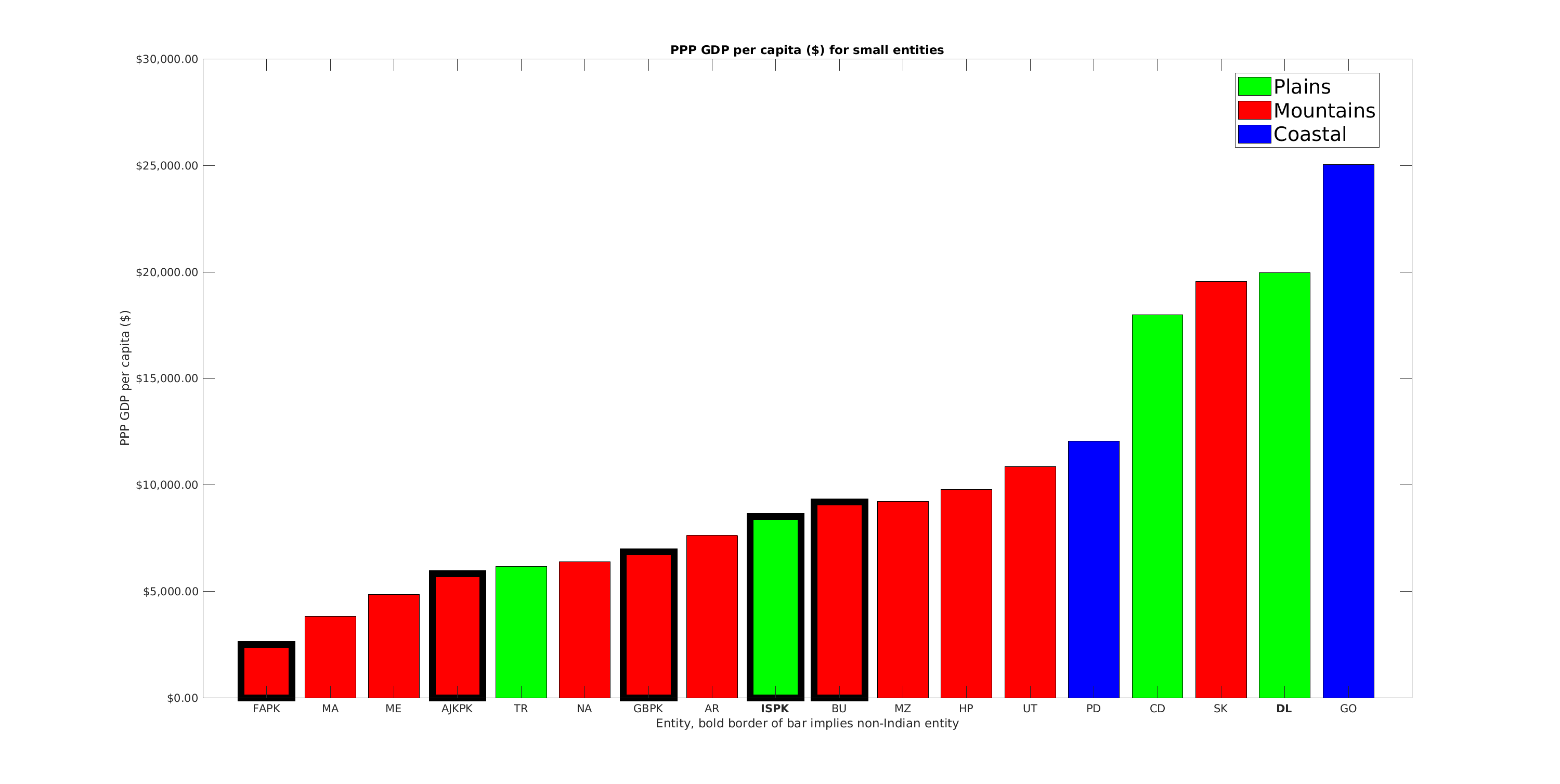
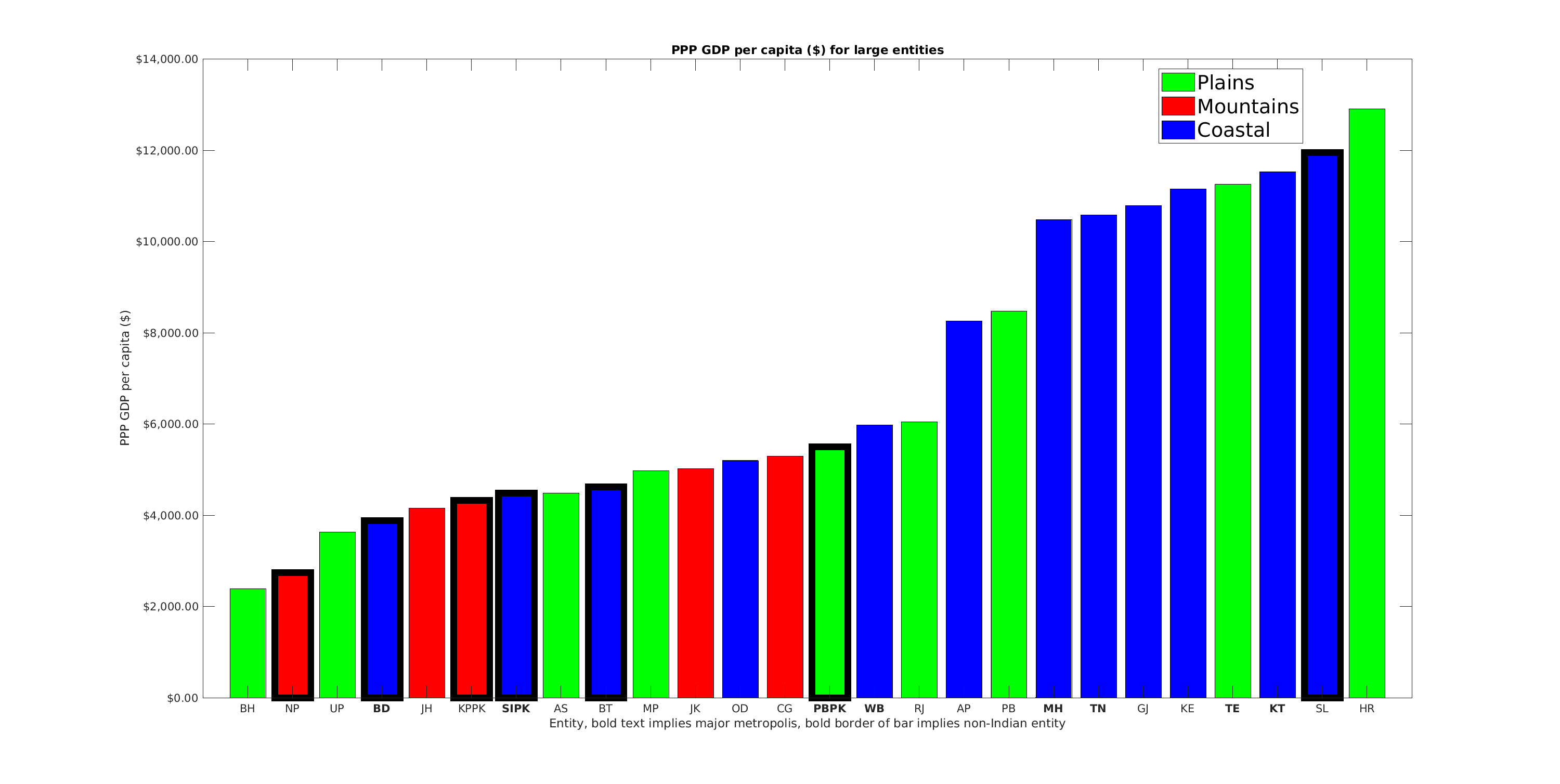
There are roughly five bands of wealth we can identify:
- Rich smaller entities of India: Goa, Delhi, Sikkim and Chandigarh. These have GDPs of around $20-25000.
- Richer large entities consisting of Indian states and Sri Lanka. GDPs are around $10-12000, and these are predominantly coastal regions.
- Succesful agrarian states of India (Punjab and Andhra), mountainous states of India (HP, UT, MZ), Pakistan’s capital Islamabad, and country of Bhutan. GDPs between $8-10000.
- Interior Indian states and Odisha, along with all Pakistani provinces. This is the South Asian mean performance of around 4-6000$.
- Poor regions: Indian states of UP, Bihar, countries of Bangladesh, Nepal, Pakistan’s remote area of FATA and India’s remote state of Manipur.
Clearly being on the coast and having a major city help in a major way. In this context, there are three regions which are major disappointments, India’s West Bengal, Bangladesh and Pakistan’s Sindh. All three are on the coast, have major metropolitan areas and even have rich agricultural lands. But their economic performance is significantly below potential.
On the other hand, the economic star of the subcontinent is the Indian state of Haryana. It defies every convention, its not on the coast, lacks a huge metro region and lacks abundant rainfall. But it excels in every aspect of economic activity, its agricultural productivity is second only to Indian Punjab, its industries are varied and well developed and its service sector is a leader in India along with Karnataka. Gurugram hosts genuinely innovative startups, home to at least 7 of India’s 30 unicorns.
An interesting comparison is that between the state of Punjab and the Pakistani province of the same name. Indian Punjab is richer despite lacking a metro area. But there is a convergence in certain aspects. These are rich agricultural areas, with strong remittance networks but they both might lack industrial entrepreneurs.
Bihar, Nepal and Eastern UP together continue to be home to the largest concentration of poor people on planet Earth. This is an isolated region, with no major cities, neglected by every Indian political entity for many centuries now. The Modi government’s national waterway one has already connected the region upto Varanasi to the ocean, upstream will be a technological challenge. Nepal, can look to Indian states like Uttarakand and Himachal for an effective growth strategy.
Although geography and history play a major role, the example of Haryana shows that those factors can be overcome. Market access, aggregation effects and the presence of mercantile communities are the key variables that determine economic performance.
Total fertility rate map in South Asia
Interesting subregional trends. I guess I will refamiliarize myself with GIS packages in R at some point and produce something like this:
Razib Khan on The Cārvāka Podcast
Razib Khan talks to Kushal Mehra
Welcome back Mahathir Mohamad, Hero of Asia! (a)
https://www.youtube.com/watch?v=7_NMXgdCP-U
This is a follow up to:
Rishabh Gulat–who I respect greatly has a different take on Datuk Mahathir Mohamad, Hero of Asia, than I do. Some argue that Datuk Mahathir has recently shifted his policy and allied with conservative Wahhabi (subset of Salafi, subset of Sunni) muslims, MBS, Saudi Arabia and Pakistan against India. Mr. Gulat implies that Datuk Mahathir is backing Brown Pundit favorite Dr. Zakir Naik against India:
https://www.youtube.com/watch?v=GfhVQoIvGIs
Please watch Mr. Gulat and come to your own conclusions.
The Indian Malays (7% of the population, 15% of the professional workforce, 40% of all Malaysian doctors, economic engine that moves Malaysia) are rallying the opposition to Datuk Mahatir. Mr. Gulat thinks the global Indian diaspora and global Eastern philosophy diaspora (presumably inclusive of Confucians, Toaists and Chinese) should back the Indian Malays in this.
I need to do a lot more research before proposing an alternative course of action. But here is a question. Can the Indian Malays, global Indian diaspora, global Eastern Philosophy, global Muraqabah tilted Sunnis and Shia and global liberal muslims unite and offer Datuk Mahathir Mohammed an offer he can’t refuse?:
There are many great and powerful Indian and Indonesian muslims–friends of PM Modi–who can make the offer.
As an aside, many Brown Pundits readers know Dr. Zakir Naik fanboy and heart throb Veedu Vidz. Please ask him to come on the Brown Pundits Podcast!
Mr. Rishabh Gulat is a great thought leader and expert on Indonesia, Malaysia and South East Asia more generally. He says that India and Indonesia should make a civilizational, cultural, economic and geopolitical alliance. Is there an interest in the Brown Pundits Podcast interviewing Mr. Rishabh Gulat?
Please let us know in the comments.
American Caste (b)
America has a national crisis in math capacity, competence and merit. American students sharply underperform students in many countries all over the world. Including Vietnam, which is a poorer country than India per capita. We will heavily refer to the 2018 OECD PISA report in below paragraphs, but the below chart graphic is from the 2015 OECD PISA scores report because math scores are reported for more countries in the 2015 report. Perhaps the 2018 report will be revised to add more countries in the future:

- United States: 8% of students scored at Level 5 or higher in mathematics
- OECD average: 11%
- Six Asian countries and economies had the largest shares of students who did so:
- Beijing, Shanghai, Jiangsu and Zhejiang (China): 44%
- Singapore: 37%
- Hong Kong (China): 29%
- Macao (China): 28%
- Chinese Taipei: 23%
- Korea: 21%
Note that these six countries were among the poorest countries in the world in the 1950s, far poorer than poor Americans or poor Europeans or poor Chileans can even imagine. In 1979 China was unbelievably poor. Much of the population of China–perhaps as many as 100 million–had starved to death because of extreme poverty in the 1970s. Poor children around the world are outperforming American children in mathematics despite extremely low education spending per student and very low socio-economic level of their legal guardians, where socio-economic level is defined as:
- income
- wealth
- formal education of parents
Do any American high school student subgroups perform well in Mathematics? Yes, “people of color” or “minority” Americans perform well in Mathematics. America’s “people of color” or “minority” students are orders of magnitude more likely to get an 800 on the mathematics SAT than European Americans. If we assume this is an extreme tail end distribution issue related to European Americans having a lower standard deviation and non standard distribution in mathematics performance relative to “people of color” or “minority” Americans, we can explore the breakdown of Americans who score between 750 and 800 on the Mathematics SAT. Here European Americans perform far better relative to “people of color” or “minority” Americans. In 2015 16,000 European Americans scored 750 or higher. 33,000 “people of color” and “minority” Americans scored 750 or higher. We further know that 51% of SAT test takers were European Americans and 49% were “people of color” or “minority” Americans. “People of color” or “minority” Americans are [33,000/16,000]*[51%/49%] or 2.15 times as likely to score 750 or higher on the mathematics SAT compared to European Americans. If we examine the 107,900 test takers who got SAT math scores of 700 or higher; 59,900 are “people of color” or “minority” Americans, versus 48,000 European Americans. “People of color” or “minority” Americans are [59,900/48,000]*[51%/49%] or 1.30 times as likely to score 700 or higher on the mathematics SAT compared to European Americans. For data junkie geeks like me there is a lot more data on SAT math score distributions here and here. The Greta Anderson article’s comment section in particular has some very intelligent commentators who have studied the American SAT score distribution. This is likely to be the subject of many future blog posts and Brown Pundits Podcasts.
What about this is worrying?:
- European Americans in particular are sharply under-performing both very poor children around the world and “people of color” and “minority” Americans in mathematics.
- American mathematics SAT scores have fallen between 1972 and 2016. 1972 is the earliest year for which I could find comparable SAT mathematics scores. In 2017, 2018 and 2019 the SAT mathematics exam was completely restructured to make scores no longer comparable to SAT mathematics scores between 1972 and 2016.
- 90% or more of current jobs and businesses are likely to be replaced by artificial intelligence (AI), brain electro-therapy (meditation . . . practiced by civilizations around the world for over 5,000 years), brain sound therapy (naad or mantra yoga and their equivalents in Native American, Egyptian, Sumerian, Taoist and other civilizations around the world for over 5,000 years), bio-engineering tissue, genetic editing, and fused AI-brain interface synthesis intelligence. Almost all of these future disciplines are complementary to mathematics.
Future articles and podcasts are planned all six of these future disciplines. If you are curious about fused AI-brain interface synthesis intelligence, please watch my main man Elon Musk:
Some say that the tension and relationship challenges between America’s four big castes–European Americans, European “Latino” Americans, Black Americans and Asian American–are driving low math scores for European Americans “AND” other Americans. One example is where thought leader Mark J Perry explores the possibility that tension between the European American caste and the Asian American caste are lowering American mathematics performance. Excerpts of his article are reproduced below:
Post Modernism (d)
Five thousand years ago the greater Egyptian, Sumerian, Eastern (defined as pan Arya plus China) civilizations were very mathematically oriented. Many caucasians appear to believe that these ancient civilizations were racist. Possibly because of this many caucasians believe that math is racist.
Another possible reason many caucasians appear to believe that math is racist is because they fear it might unfairly advantages “brown” people (Asians, Arabs, Latinos) and “brown” cultures (eastern philosophy including Toaism and Confucianism, native american religion) at the expense of caucasians in the new global artificial intelligence, neuroscience, genetics economy.
Could part of the anger against math come from fear that mathematics, science, technology, seeking the truth through thought, seeking the truth without thought might be haram or blasphemous? (Obviously most Abrahamics do not believe this and this is not a critique of Abrahamism.)
I believe that mathematics is part of art; and that it derives from beyond normal gross thought. From what in Sanskrit is called Buddhi, Vijnayamaya Kosha, Ananda Maya Kosha, Sukshma Sharira, Kaarana Sharira, the subtle heavens.
Perhaps the anger against mathematics is part of a deeper anger against the subtle heavens? If so, one possible way to look at this is that to transcend the subtle heavens (including mathematics) it might be helpful to love them and love our way through them. Or to love and respect the racist (subtle heavens–including mathematics) until we transcend the various subtleties of thought and feeling.
What are everyone’s thoughts?
+++++++++++++++++++++++++++++++++++++++++++++++++++
Is it time for Asian Americans and Latino Americans to ask to be considered “white”? (c)
This is the next article in the series “Is it time for Asian Americans and Latino Americans to ask to be considered “white”, “Is it time for Asian Americans and Latino Americans to ask to be considered “white” (a)”, Razib’s “Hasan Minhaj’s Patriot Act on Affirmative Action“, and “Is it time for Asian Americans and Latino Americans to ask to be considered “white” (b)”.
A growing part of the global caucasian intelligentsia are attacking Hong Kong protesters as far right fascists. This is part of a growing trend among xenophobic caucasians attacking Asians for “white supremacy”, “nazism”, “racism”, “oppression”, “patriarchy”, “imperialism”, “colonialism”, “hegemony”, “exploitation.”
Why is this happening? Is it just jealousy? Is it that many caucasians fear that “darkies” own a growing percentage of global wealth, earn a growing percentage of global income? Is it fear that “darkies” have growing competence, capacity, merit, mental health, intelligence? Is it fear about improving “darkie” academic outcomes?
I am not sure. Can everyone share their thoughts?
How should us “darkies” react?
I believe in loving and respecting our enemy with all our hearts, all our souls, all our minds and all our might. This includes everyone who is disrespectful, not loving, racist, bigoted, prejudiced, white supremacist, Nazi, facist, oppressive, hegemonic, exploitative, patriarchal towards us. And everyone who accuses us of being disrespectful, not loving, racist, bigoted, prejudiced, white supremicist, Nazi, facist, oppressive, hegemonic, exploitative, patriarchal. And everyone who labels and mislabels us. And everyone who falsely accuses us.
Everyone has the right to freedom of art and thought. If we truly love and respect others, then how can we not respect their right to disrespect and not love us?
The sweetness of love will gradually melt their hearts.
Some might say that this works for most people who are mean to others, but is insufficient for dangerous people. For particularly dangerous people, we can combine the deepest of love and respect with dialogue. And for the most dangerous people, we can combine love, respect, and dialogue with other things.
Can there be any other way?
This topic is one of the reasons The Brown Pundits Podcast would like to interview Irshad Manji:
Irshad Manji has touched the sweetness of the heart, the silence that is always with us. And while I agree with her that we should respect and love others, and not label others. I don’t think we have the right to limit the freedom of art and thought of others by asking them not to label and mislabel us.
One example that inspires me is how Krishna dealt with harsh bigotry, criticism, false allegations, others mislabeling him, disrespect, bigotry, prejudice, white supremacy, Nazism, fascism, oppression, hegemony, exploitation, patriarchy. Krishna insisted that others be allowed to criticize Krishna.
I would be curious to listen to Irshad Manji’s thoughts about this.
